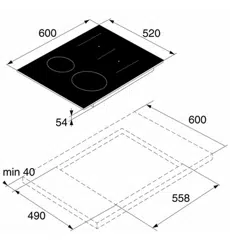Loading ...
Loading ...
Loading ...

EN 8
USE
Induction noises
Ticking sound
• A light ticking sound is caused by the capacity limiter on the front and back zones. A soft
ticking sound can also occur at lower settings.
Pans are making noise
• The pan can make sounds during cooking. This is caused by the energy flowing from the
hob to the pan. This is normal for certain pans, particularly at high settings. This is not
harmful for the pans or the hob.
The fan is making noise
• In order to increase the lifespan of electronic components, the appliance is fitted with a
ventilator. If you use the appliance intensively, the ventilator will be switched on and you will
hear a humming sound. The ventilator can also make sounds after you have switched off
the appliance.
Pans
Always place a pan in the middle of a cooking zone. In Bridge function always use a (fish) pan
where at least one of the centre/middle positions of the linked zones is covered.
Pans for induction cooking
Induction cooking requires a particular quality of pan.
Pans that have already been used for cooking on a gas hob are no longer suitable
for use on an induction hob.
• Only use pans that are suitable for electric and induction cooking with:
▷ a thick base (minimum 2.25 mm);
▷ a flat base.
• The best are pans with the ‘Class Induction’ quality mark.
You can use a magnet to check whether your pans are suitable.
A pan is suitable if the base of the pan is attracted by the magnet.
Suitable Unsuitable
Special stainless steel pans Earthenware
Class Induction Stainless steel
Hard-wearing enamelled pans Porcelain
Enamelled cast-iron pans Copper / Aluminium
Plastic
Loading ...
Loading ...
Loading ...
